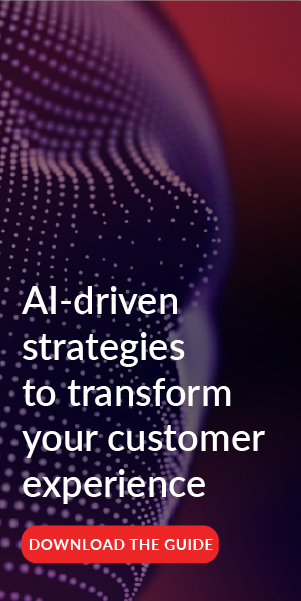Topics
How to personalize customer experience with insights throughout the customer journey

Have you ever tried to walk in your customer’s shoes?
Decision makers must craft exceptional customer experiences. But to do that, they have to know what their customers are actually experiencing. If you can’t measure it, you can’t improve it.
Personalization has become an enormous part of CX. Forbes’s 2024 State of Customer Service and CX Study uncovers how little patience today’s customer has for a generic experience: “We found that 81% of customers prefer companies that offer a personalized experience, and 70% say a personalized experience in which the employee knows who they are and their history with the company (past purchases, buying patterns, support calls and more) is important.”
But how do you achieve the perfect personalized experience? The only way to do it is by leveraging data and harnessing insights from the customer journey. With this intelligence, you can create tailored interactions that resonate with your audience.
Personalization in customer experience
Personalization in CX refers to customizing interactions based on individual customer data, preferences, and behaviors. It encompasses everything from personalized marketing messages to tailored customer support.
In addition to Forbes's recent findings, research from Epsilon found that “the appeal for personalization is high, with 80% of respondents indicating they are more likely to do business with a company if it offers personalized experiences and 90% indicating that they find personalization appealing.”
Poor or ineffective personalization can also negatively impact brand reputation and customer retention. Customers likely have other options from companies that already understand the customer journey. Failing to meet their expectations can lead to increased churn rates. Businesses must use personalization strategies at every point of the customer journey to maintain their competitive edge.
The customer journey and its touchpoints
The customer journey is a roadmap that outlines the stages a customer goes through when interacting with a brand, from awareness to support. Each stage presents unique opportunities to gather insights that can inform the effectiveness of your personalization efforts.
Awareness
Awareness is when potential customers first hear about your brand. Data analytics can help identify the best ways to reach your target audience. These insights enable you to craft messages that resonate with specific demographics within their first few moments of knowing you exist.
Consideration
The consideration phase is when customers evaluate their options. Collecting feedback through surveys and social media interactions helps you better understand customer preferences. It can also keep you informed about customer needs and expectations for your specific type of business.
Purchase
Personalization can significantly impact conversion rates during the purchase stage. Analyzing past purchase behavior and preferences provides critical insight that can increase the chances of a sale. While this isn’t necessarily simple with new customers, understanding the general preferences of specific types of customers can help by offering recommendations for certain products.
Support
The support phase is where personalization can make or break the customer experience. It’s vital to leverage insights gathered during previous interactions so you can provide tailored support that addresses specific customer issues.
Support is such a significant part of the customer journey that it’s worth delving deeper into what customers expect at this stage after they’ve already put their faith in a company.
Support: The customer journey’s final frontier
The customer journey “concludes” with support. However, support is often an ongoing process, which makes it easily the most essential aspect of the journey. If customers feel abandoned in the final hour, it can sour them on the whole experience.
Providing tailored support that uses new tech, like AI-driven tools, is one of the best ways to enhance the overall customer experience and build trust between brand and buyer. IBM’s findings offer insight into how valuable these tools are: “Improving the hyper-personalization of customer experience was identified as a top use case by 42% of AI decision-makers.” AI-driven CX tools can:
- offer contextual information about the customer’s inquiry before the interaction, minimizing the need for customers to repeat themselves;
- give agents recommendations and information in real time, including suggesting solutions and best actions to ensure customer satisfaction; and
- summarize the conversation between agent and customer while automating essential action items to ensure the customer receives timely follow-ups.
These all help you deliver the personalized customer journey that keeps people coming back. There’s no real reason for them to do business with a brand that doesn’t understand their needs and struggles or treat them as individuals—especially when so many others will.
Implementing personalization at the contact center
Considering how vital support is to a successful customer journey, contact center personalization is a must for improving CX. Here are some ways contact centers can provide a more personal experience.
Understanding caller intent
Who is calling your business and why? You need to understand this before you can make any attempts at personalization. Do this by:
- implementing caller ID technology to allow agents to identify returning customers; and
- analyzing previous interactions to understand the customer’s preferences and pain points.
Here, again, we see that digital automation is an enormous asset. AI can do everything from pulling up detailed information about a caller, so it’s ready for the agent, to gauging a customer’s emotional state before a call.
Automated self-service options
Implementing digital automation and self-service options allow customers to resolve simple inquiries without a human agent. These tools can be available 24-7 to provide customers with immediate support, freeing up agents to focus on more complex issues. They use conversational and generative AI and visuals to guide the customer journey to a successful conclusion.
Behavioral trigger campaigns
Follow-up emails after customer contact can include recommendations for related products, advance notice of upcoming sales, or informative content about what they’re interested in buying. Behavioral trigger campaigns are most effective when set up automatically to reach the customer shortly after the behavior, so the message stays relevant and personal.
Adapting CX for different generations
Personalization means meeting every individual customer’s expectations. However, different generations often have very different expectations. Gartner found that “38% of Gen Z and millennial customers say they’re likely to give up on resolving a customer service issue if it can’t be resolved in self-service.”
The same survey found that “just 11% of baby boomers will give up if they can’t resolve their issue in self-service.” The marked difference in customer service expectations means that business leaders need to understand how each generation wants their journey to start and finish.
Baby boomers
This generation often prefers direct communication through phone calls and appreciates personalized interactions. They may need more time to adapt to digital solutions and will often bypass them to speak with a representative.
Gen X
Gen X customers value efficiency and may prefer a mix of phone and digital communication. They appreciate personalized support but also expect quick resolutions.
Millennials
Millennials are more tech-savvy and prefer digital communication methods that leverage AI, like chat. They appreciate personalized experiences and want brands to understand their preferences as much as any other generation.
Gen Z
Gen Z is about speed and convenience. They prefer brands that provide personalized experiences across all channels, including apps and social media.
Businesses should offer support through multiple channels, regardless of which generation they’re connecting with. Omnichannel support is the best way to ensure you’re accommodating varying preferences.
Empathy and emotional intelligence are also vital for creating personalized experiences. Training staff to respond to customer emotions makes interactions more manageable for everyone; AI solutions, while helpful, don’t provide the human touch customers crave.
Using insights for improved personalization
The best way to use these insights to your advantage is with a systematic approach. Here’s how you can enhance personalization efforts even further:
- collect data through surveys and feedback forms to better understand preferences and expectations;
- leverage AI-driven analytics tools to gather insights from everywhere, including website behavior and social media engagement;
- use behavioral analysis to identify trends and patterns within your customer base; this includes knowing what products or services are most popular among customers;
- train staff to use customer data to provide better support during calls; and
- establish a feedback loop to monitor customer satisfaction and adjust personalization strategies.
Many companies are already using personalization to enhance CX. Amazon uses a recommendation engine through generative AI that provides personalized product suggestions. They can then use the same data to provide personalized support. When customers contact support, CX agents can quickly access relevant order information, making it much faster to resolve issues related to specific products.
Guiding the customer journey with personalized CX
Personalization prevents the customer from feeling like a dollar sign instead of a human being. Businesses should leverage insights from every point in the customer journey, gathering as much intel as possible to improve interactions across all touchpoints.
But even more importantly, business leaders should embrace AI and data analytics to deliver personalized experiences. Your competitors already are. Build a lasting relationship with your customers to rise above the competition.
Customers have a choice. Make sure they choose you.
Download "How AI should enhance your customer experience in 2025: A guide to finding the right BPO innovation partner" to learn more about how these innovations are enhancing the customer experience.


